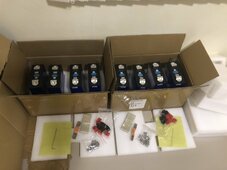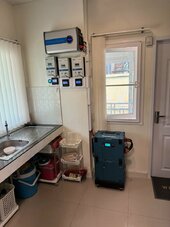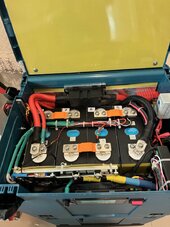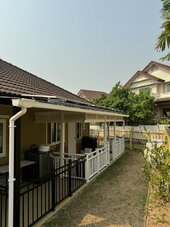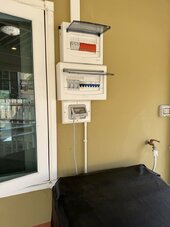After receiving some great support from this forum (helped a lot to get my first DIY solar set-up), and having now recently upgraded my solar system with a completely new set-up (the old set-up now installed to another property elsewhere)…, I just wanted to share a little of the good with new purchase I made, and also a bad experience during the whole thing…, and so to give some feedback in the hope it may prove of some help to others I decided to boast my thing, My DIY solar system is a domestic household setup, I live in Thailand with plenty of sun power and decided last year to upgrade from 12v to 24v system, from 2off Trina 545w solar panels, to 3off Longi 555w panels, I then changed my lifepo Lf280ah battery set from 12v (4off) to LF280K 24v (8off), and also changed my Epever IPower Inverter from 12v 3kw model to an Epever IPower 24v 3 kw model, then I added an extra Epever MPPT controller complete with monitor (for the added solar panel), the solar panels are wired in parallel and charging with the extra solar panel is so much more improved…, all went well with the upgrade install…, and with the flick of a switch each morning, it now provides me full daylight hours (currently 7am to 6pm) of typical domestic power use (excl. the 4.5kw electric shower), with the normal intermittent use of aircon, kettle, iron, air fryer, microwave and washing machine etc. and on most days still leaves around 30+% of battery power to help out if normal power should go off a night... So, with help from the forum and a self-pat on the back done, I’m currently really pleased with my upgrade… But now I would like to pass on some of the good and bad along the way. So, firstly the bad, the new Inverter I purchased was another Epever type 3kw 24v, and works perfectly well, however the old previous installed inverter (Epever 3kw 12v) I removed and installed in a second property (smaller), along with the old solar cells, battery set, controllers and monitors etc., to provide similar set-up for daytime power and back-up on power outage…, but without thought I connected all to the house with a different earthing system (Neutral earthed at the incoming power box), and so without considering the fact that Epever Inverters output must not be connected to Neutral earthed systems, it wasn’t long after first trial tests that the Inverter went bang and is now destroyed...:/ I have now replaced the blown-up inverter for same type, and modified the house wiring to none neutral earth, and all is now good... so, for those unaware I hope my failure helps… now for the good…, I consider the good has been with my choice of new battery cells types (LF280K, 280ah), they have so far proved a good buy with better balancing and naturally extended but extended cycle. I remember looking on the forum for comments on cell types and suppliers so, if anyone is currently looking for quality performance cells at 280ah, I can recommend these LF280K... and if interested they can confidently be purchased via Alibaba, (my seller:, Dongguan Lighting New Energy Technology Co., Ltd.), a good purchasing experience (great support staff - Rain Zeng), the cells have large connecting posts and came with all the accessories including bus bars, Insulating boards, fiber tape, terminal insulators and fixing tool (hex key), delivered quick and arrived in an outer wooden crate.., they provide quick answers to queries and provided me a video clip of my cells being tested before shipment (cell volts and resistance matching)…, I have attached some ‘show off’ pics, and if anyone wants a little more detail on the above please feel free to ask… Cheers, Terry.
You are using an out of date browser. It may not display this or other websites correctly.
You should upgrade or use an alternative browser.
You should upgrade or use an alternative browser.
Solar Upgrade 12v to 24v
- Thread starter Terry.M
- Start date
pollenface
Solar Addict
Very neat setup!
Some inverters are not designed for neutral to earth grounding. Mine aren't. The issue arises when certain appliances won't function correctly without ground-neutral bond. So far so good here though
Some inverters are not designed for neutral to earth grounding. Mine aren't. The issue arises when certain appliances won't function correctly without ground-neutral bond. So far so good here though
Last edited:
timselectric
If I can do it, you can do it.
- Joined
- Feb 5, 2022
- Messages
- 18,764
There's no way in hell that I would install a non grounded electrical system in a house.
That's a scary situation.
If you are a hermit, you are only putting your own safety at risk.
But family and friends are going to assume that they are safe, when they are not.
That's a scary situation.
If you are a hermit, you are only putting your own safety at risk.
But family and friends are going to assume that they are safe, when they are not.
Okay..., I understand your view, and clearly having no gounded system in the property would be leathal.., but that is not in fact the case..., If I can try to explain further..., I did say the 'Neutral was earthed at the Incoming power box' (Incoming main earth wire from the 'ground rod' outside the house) but was then also linked across from the main Netral bar to the main Earth bar at the Power box... So, to remove the earth link simply takes the Neutral from being directly connected to earth at the Power box house point, but leaves the main earth bar connected to Earth ground along with all the household points with electrical connection to the power box..., and therefore by disconnecting the main Earth wire link from the Neutral, leaves the main Earth connection 'as was' on elsewhere.. and so any fault leak to Earth whether appliance or human will be detected by the earth leakage protection device at the power box as norm (i.e 30ma Earth leakage circuit breaker)... and leaving the Neutral at above ground potential (volts) directly at the property, and also without issue to its duty or function... the Inverter can now safely centre earth it's output as designed, and therefore also be earthed... hope makes sense...!!There's no way in hell that I would install a non grounded electrical system in a house.
That's a scary situation.
If you are a hermit, you are only putting your own safety at risk.
But family and friends are going to assume that they are safe, when they are not.
timselectric
If I can do it, you can do it.
- Joined
- Feb 5, 2022
- Messages
- 18,764
Yes, it makes perfect sense.Okay..., I understand your view, and clearly having no gounded system in the property would be leathal.., but that is not in fact the case..., If I can try to explain further..., I did say the 'Neutral was earthed at the Incoming power box' (Incoming main earth wire from the 'ground rod' outside the house) but was then also linked across from the main Netral bar to the main Earth bar at the Power box... So, to remove the earth link simply takes the Neutral from being directly connected to earth at the Power box house point, but leaves the main earth bar connected to Earth ground along with all the household points with electrical connection to the power box..., and therefore by disconnecting the main Earth wire link from the Neutral, leaves the main Earth connection 'as was' on elsewhere.. and so any fault leak to Earth whether appliance or human will be detected by the earth leakage protection device at the power box as norm (i.e 30ma Earth leakage circuit breaker)... and leaving the Neutral at above ground potential (volts) directly at the property, and also without issue to its duty or function... the Inverter can now safely centre earth it's output as designed, and therefore also be earthed... hope makes sense...!!
And again, there's no way in hell that I would install an ungrounded electrical system in my house. If the equipment is not designed to be safe, I would return it for a full refund.
You're no doubt right about ground neutrals, but as you say no probs as yet, and cheers for your comment..Very neat setup!
Some inverters are not designed for neutral to earth grounding. Mine aren't. The issue arises when certain appliances won't function correctly without ground-neutral bond. So far so good here though
Sorry, maybe me, but I'm not quite understanding...., if okay, I think I will leave it as this. The electrical system in my house was, is and always has been equipped with a grounded Earth. the difference between blowing-up my Inverter and no loger blowing my (new replacent) Inverter is, I have now removed a pointless Neutral to Earth link from the power box, which unessasarily tied the Neutral bus bar to the Earth bus bar (at the power box), once the link is removed (the link provides for none-grounded earth connection at the property, to ensure for a return path with any earth leakage)... The fact that my Neutral is earthed at source (transformer star point) and with local grounding Earth (earth rod at the house), the fault path returning to source is via ground... So when my solar is switched onto the power box it's done through a change-over switch that isolates authority Live and Neutral supply on to the power box and switches through the Inverter Live and Neutral to the power box and visa versa (with the c/o switch), therefore always isolating the Inverter from the authority supply, and as the Inverter design must be provoded an Earth to ground path (it both star points it and also provides for protection devices to be installed for earth leakage (elcb circuit breaker in domestic side of the power box), the Inverter can then operate as designed (as mine now does) and function without issue... and the 'designed to be safe' blown inverter cannot therefore be returned for full refund..., just need to read and fully action the Installation manual (my failing).. but my house is and was alway earth leakage protected (30ma) whichever supply souce is enabled... cheers, Terry.MYes, it makes perfect sense.
And again, there's no way in hell that I would install an ungrounded electrical system in my house. If the equipment is not designed to be safe, I would return it for a full refund.
timselectric
If I can do it, you can do it.
- Joined
- Feb 5, 2022
- Messages
- 18,764
You are confusing "earth" (dirt) with "protective earth" (the electrical safety grounding system).
Dirt is a horrible conductor. You can't expect it to be a return path to the source for fault current. (Maybe during a monsoon)
The fact that "it works" , doesn't mean that it's safe.
Good luck to you and your family.
Since luck is all that you are relying on for safety.
Dirt is a horrible conductor. You can't expect it to be a return path to the source for fault current. (Maybe during a monsoon)
The fact that "it works" , doesn't mean that it's safe.
Good luck to you and your family.
Since luck is all that you are relying on for safety.
pollenface
Solar Addict
what a top blokeGood luck to you and your family.
Since luck is all that you are relying on for safety.
Maybe silly of me wanting to reply, and don't get me wrong I do respect your sincere view, but my only confusion is with your lack of understanding that a dirt connection is exactly where the term earthing comes from..., but dirt connection can only be called a protective earth connection if properly installed, the likes an uninterrupted metal conductor, driven deeply into the ground of your property, some 2 to 3 meters or more..., and that will without luck, or monsoon, provide sufficiently low enough impedance to operate any decent safety devise anytime (RCD an obvious essential addition to this method)... This system is a well recognised means of providing safe means of domestic earth protection, it's one I grew up with in the UK, and no doubt is used widely elsewhere in the world, but I do feel there is added benifits to this method of earthing over that my power box previously provided (Neutral linked to earth), with the likes of broken line neutral connection fault (affecting earth fault return paths and lethel in raising earth volts), or overhead line neutral to phase short (taking earthed appliences to phase volts, also lethal)..., and in my view with Thailand's extremely poor electrical safety culture, regarding the lack of earthing (two prong plugs still widely used), and poor inferstructure of distribution with the 'H pole transformer sets regulary blowing-up in bad weather, and lines poorly installed or maitained (too close to potential tree branch falls etc)..., I therefore feel confident at my home that my family are well protected with all required earthing points connected to the well established method of providing an electrical safety grounding system to your home... naturally you are welcome to stand by your view, I will mine...You are confusing "earth" (dirt) with "protective earth" (the electrical safety grounding system).
Dirt is a horrible conductor. You can't expect it to be a return path to the source for fault current. (Maybe during a monsoon)
The fact that "it works" , doesn't mean that it's safe.
Good luck to you and your family.
Since luck is all that you are relying on for safety.
timselectric
If I can do it, you can do it.
- Joined
- Feb 5, 2022
- Messages
- 18,764
Incorrect knowledge can be more dangerous than no knowledge at all.
The purpose of the grounding system is to provide a low impedance (resistance) path for fault current , back to the source. So that the protection device (breaker or fuse) can clear the fault. This path is only made possible through the N/G bond (what you call the "neutral earth link").
By removing this connection, you have removed the fault current path.
And now are relying on the (very low conductive) dirt, to provide this path.
Sadly, I don't think that I can change what you think you know.
I can only hope that you don't learn it out the hard way.
All that I can do is wish you good luck.
The purpose of the grounding system is to provide a low impedance (resistance) path for fault current , back to the source. So that the protection device (breaker or fuse) can clear the fault. This path is only made possible through the N/G bond (what you call the "neutral earth link").
By removing this connection, you have removed the fault current path.
And now are relying on the (very low conductive) dirt, to provide this path.
Sadly, I don't think that I can change what you think you know.
I can only hope that you don't learn it out the hard way.
All that I can do is wish you good luck.
Apreciate you good luck wish, but is now clear where the lack of knowledge appears..., part correct in your script the word 'only' fails to aknowledge alternative earthing systems widely used, and the safety they employ is in using high sensitivity Residual Current Devices (a replacement to the old lesser reliable voltage elcb types, and were developed quite some years ago now)... these devices perform extremely well, operating at 5, 10, or 30 milli amps (choices), and therefore irrespective the conditions (monsoon or not) an initial earth electrode (a decent well installed electrode) test, will provide suitable confidence of its function..., and unless your property has been built on a plastic waste bottle landfill, the likeyhood of such a change to a ground resistance preventing its function would not be unlucky but extremely unlikely, to the point, if the systems had proven unreliable they would no longer be (as with the elcb) recognised as legal for employment... but these systems do infact benifit from the safety concerns offered with alternative systems..., I choose what I'm familiar, and to finish this chat, I stand my dry (no rain to speak of this year) but safe ground... and for differing reasons, good luck to us all..Incorrect knowledge can be more dangerous than no knowledge at all.
The purpose of the grounding system is to provide a low impedance (resistance) path for fault current , back to the source. So that the protection device (breaker or fuse) can clear the fault. This path is only made possible through the N/G bond (what you call the "neutral earth link").
By removing this connection, you have removed the fault current path.
And now are relying on the (very low conductive) dirt, to provide this path.
Sadly, I don't think that I can change what you think you know.
I can only hope that you don't learn it out the hard way.
All that I can do is wish you good luck.
Similar threads
- Replies
- 5
- Views
- 194
- Replies
- 10
- Views
- 277
- Replies
- 34
- Views
- 663
- Replies
- 7
- Views
- 245



